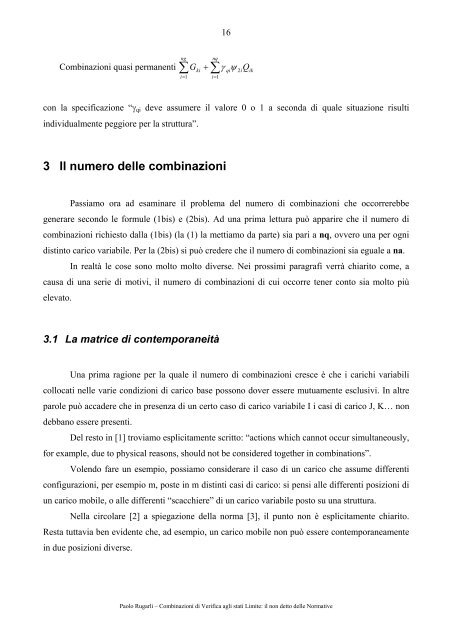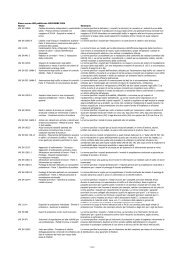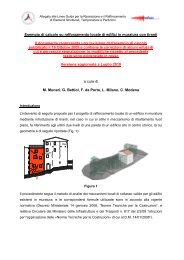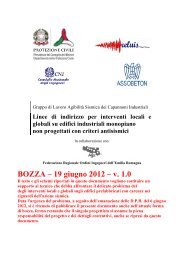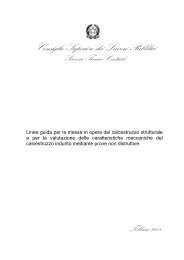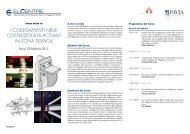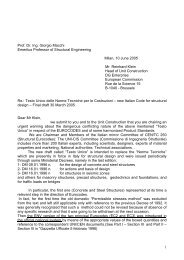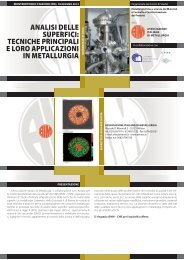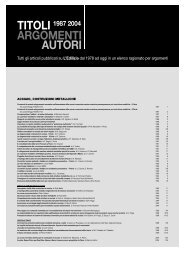Combinazioni di Verifica agli stati Limite: il non ... - Steelchecks.com
Combinazioni di Verifica agli stati Limite: il non ... - Steelchecks.com
Combinazioni di Verifica agli stati Limite: il non ... - Steelchecks.com
You also want an ePaper? Increase the reach of your titles
YUMPU automatically turns print PDFs into web optimized ePapers that Google loves.
16<br />
<strong>Combinazioni</strong> quasi permanenti ∑ G ki<br />
+ ∑γ<br />
qiψ<br />
2iQ<br />
ng<br />
i=<br />
1<br />
nq<br />
i=<br />
1<br />
ik<br />
con la specificazione “γ qi deve assumere <strong>il</strong> valore 0 o 1 a seconda <strong>di</strong> quale situazione risulti<br />
in<strong>di</strong>vidualmente peggiore per la struttura”.<br />
3 Il numero delle <strong>com</strong>binazioni<br />
Passiamo ora ad esaminare <strong>il</strong> problema del numero <strong>di</strong> <strong>com</strong>binazioni che occorrerebbe<br />
generare secondo le formule (1bis) e (2bis). Ad una prima lettura può apparire che <strong>il</strong> numero <strong>di</strong><br />
<strong>com</strong>binazioni richiesto dalla (1bis) (la (1) la mettiamo da parte) sia pari a nq, ovvero una per ogni<br />
<strong>di</strong>stinto carico variab<strong>il</strong>e. Per la (2bis) si può credere che <strong>il</strong> numero <strong>di</strong> <strong>com</strong>binazioni sia eguale a na.<br />
In realtà le cose sono molto molto <strong>di</strong>verse. Nei prossimi paragrafi verrà chiarito <strong>com</strong>e, a<br />
causa <strong>di</strong> una serie <strong>di</strong> motivi, <strong>il</strong> numero <strong>di</strong> <strong>com</strong>binazioni <strong>di</strong> cui occorre tener conto sia molto più<br />
elevato.<br />
3.1 La matrice <strong>di</strong> contemporaneità<br />
Una prima ragione per la quale <strong>il</strong> numero <strong>di</strong> <strong>com</strong>binazioni cresce è che i carichi variab<strong>il</strong>i<br />
collocati nelle varie con<strong>di</strong>zioni <strong>di</strong> carico base possono dover essere mutuamente esclusivi. In altre<br />
parole può accadere che in presenza <strong>di</strong> un certo caso <strong>di</strong> carico variab<strong>il</strong>e I i casi <strong>di</strong> carico J, K… <strong>non</strong><br />
debbano essere presenti.<br />
Del resto in [1] troviamo esplicitamente scritto: “actions which cannot occur simultaneously,<br />
for example, due to physical reasons, should not be considered together in <strong>com</strong>binations”.<br />
Volendo fare un esempio, possiamo considerare <strong>il</strong> caso <strong>di</strong> un carico che assume <strong>di</strong>fferenti<br />
configurazioni, per esempio m, poste in m <strong>di</strong>stinti casi <strong>di</strong> carico: si pensi alle <strong>di</strong>fferenti posizioni <strong>di</strong><br />
un carico mob<strong>il</strong>e, o alle <strong>di</strong>fferenti “scacchiere” <strong>di</strong> un carico variab<strong>il</strong>e posto su una struttura.<br />
Nella circolare [2] a spiegazione della norma [3], <strong>il</strong> punto <strong>non</strong> è esplicitamente chiarito.<br />
Resta tuttavia ben evidente che, ad esempio, un carico mob<strong>il</strong>e <strong>non</strong> può essere contemporaneamente<br />
in due posizioni <strong>di</strong>verse.<br />
Paolo Rugarli – <strong>Combinazioni</strong> <strong>di</strong> <strong>Verifica</strong> <strong>agli</strong> <strong>stati</strong> <strong>Limite</strong>: <strong>il</strong> <strong>non</strong> detto delle Normative


